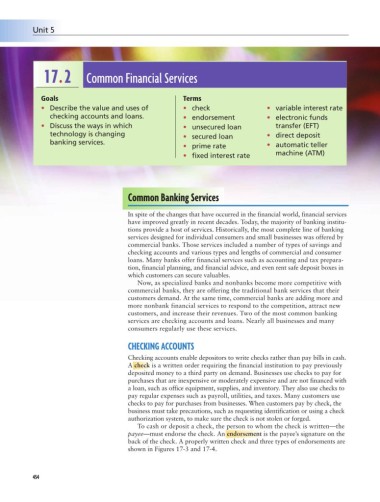Page 467 - Business Principles and Management
P. 467
Unit 5
17.2 Common Financial Services
Goals Terms
• Describe the value and uses of • check • variable interest rate
checking accounts and loans. • endorsement • electronic funds
• Discuss the ways in which • unsecured loan transfer (EFT)
technology is changing • secured loan • direct deposit
banking services.
• prime rate • automatic teller
• fixed interest rate machine (ATM)
Common Banking Services
In spite of the changes that have occurred in the financial world, financial services
have improved greatly in recent decades. Today, the majority of banking institu-
tions provide a host of services. Historically, the most complete line of banking
services designed for individual consumers and small businesses was offered by
commercial banks. Those services included a number of types of savings and
checking accounts and various types and lengths of commercial and consumer
loans. Many banks offer financial services such as accounting and tax prepara-
tion, financial planning, and financial advice, and even rent safe deposit boxes in
which customers can secure valuables.
Now, as specialized banks and nonbanks become more competitive with
commercial banks, they are offering the traditional bank services that their
customers demand. At the same time, commercial banks are adding more and
more nonbank financial services to respond to the competition, attract new
customers, and increase their revenues. Two of the most common banking
services are checking accounts and loans. Nearly all businesses and many
consumers regularly use these services.
CHECKING ACCOUNTS
Checking accounts enable depositors to write checks rather than pay bills in cash.
A check is a written order requiring the financial institution to pay previously
deposited money to a third party on demand. Businesses use checks to pay for
purchases that are inexpensive or moderately expensive and are not financed with
a loan, such as office equipment, supplies, and inventory. They also use checks to
pay regular expenses such as payroll, utilities, and taxes. Many customers use
checks to pay for purchases from businesses. When customers pay by check, the
business must take precautions, such as requesting identification or using a check
authorization system, to make sure the check is not stolen or forged.
To cash or deposit a check, the person to whom the check is written—the
payee—must endorse the check. An endorsement is the payee’s signature on the
back of the check. A properly written check and three types of endorsements are
shown in Figures 17-3 and 17-4.
454

